Potrebujeme váš súhlas na využitie jednotlivých dát, aby sa vám okrem iného mohli ukazovať informácie týkajúce sa vašich záujmov. Súhlas udelíte kliknutím na tlačidlo „OK“.
ASTM C1368-10
Standard Test Method for Determination of Slow Crack Growth Parameters of Advanced Ceramics by Constant Stress-Rate Strength Testing at Ambient Temperature
Automaticky preložený názov:
Štandardná skúšobná metóda pre stanovenie pomalé šírenie trhlín parametre pre pokročilých keramiky neustálom strese-Rate Pevnosť Testovanie pri izbovej teplote
NORMA vydaná dňa 1.12.2010
Informácie o norme:
Označenie normy: ASTM C1368-10
Poznámka: NEPLATNÁ
Dátum vydania normy: 1.12.2010
Kód tovaru: NS-10886
Počet strán: 11
Približná hmotnosť: 33 g (0.07 libier)
Krajina: Americká technická norma
Kategória: Technické normy ASTM
Kategórie - podobné normy:
Anotácia textu normy ASTM C1368-10 :
Keywords:
advanced ceramics, biaxial flexure, constant stress-rate testing, equibiaxial flexural strength, flexural strength, flexural testing, four-point flexure, slow crack growth, slow crack growth parameters, tensile strength, Advanced ceramics, Constant stress-rate flexural testing, Cracking--ceramics, Elevated temperature tests, Flexural testing--ceramics, Four-point flexure, Monolithic advanced ceramics, Slow crack growth (SCG), Tensile properties/testing--ceramics
Doplňujúce informácie
| Significance and Use | ||||||||||||||||||||||
|
For many structural ceramic components in service, their use is often limited by lifetimes that are controlled by a process of SCG. This test method provides the empirical parameters for appraising the relative SCG susceptibility of ceramic materials under specified environments. Furthermore, this test method may establish the influences of processing variables and composition on SCG as well as on strength behavior of newly developed or existing materials, thus allowing tailoring and optimizing material processing for further modification. In summary this test method may be used for material development, quality control, characterization, and limited design data generation purposes. The conventional analysis of constant stress-rate testing is based on a number of critical assumptions, the most important of which are listed in the next paragraphs. The flexural stress computation for the rectangular beam test specimens or the equibiaxial disk flexure test specimens is based on simple beam theory, with the assumptions that the material is isotropic and homogeneous, the moduli of elasticity in tension and compression are identical, and the material is linearly elastic. The average grain size should be no greater than one fiftieth of the beam thickness. |
||||||||||||||||||||||
| 1. Scope | ||||||||||||||||||||||
|
1.1 This test method covers the determination of slow crack growth (SCG) parameters of advanced ceramics by using constant stress-rate rectangular beam flexural testing, or ring-on-ring biaxial disk flexural testing, or direct tensile strength, in which strength is determined as a function of applied stress rate in a given environment at ambient temperature. The strength degradation exhibited with decreasing applied stress rate in a specified environment is the basis of this test method which enables the evaluation of slow crack growth parameters of a material. Note 1—This test method is frequently referred to as “dynamic fatigue” testing (Refs (1-3) ) in which the term “fatigue” is used interchangeably with the term “slow crack growth.” To avoid possible confusion with the “fatigue” phenomenon of a material which occurs exclusively under cyclic loading, as defined in Terminology E1823, this test method uses the term “constant stress-rate testing” rather than “dynamic fatigue” testing. Note 2—In glass and ceramics technology, static tests of considerable duration are called “static fatigue” tests, a type of test designated as stress-rupture (See Terminology E1823). 1.2 Values expressed in this test method are in accordance with the International System of Units (SI) and . 1.3 This standard does not purport to address all of the safety concerns, if any, associated with its use. It is the responsibility of the user of this standard to establish appropriate safety and health practices and determine the applicability of regulatory limitations prior to use. |
||||||||||||||||||||||
| 2. Referenced Documents | ||||||||||||||||||||||
|
Podobné normy:
Historická
1.8.2013
Historická
1.8.2013
Historická
1.6.2010
Historická
1.12.2010
Historická
1.6.2010
Historická
1.12.2010


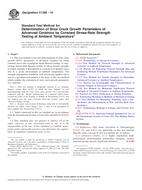
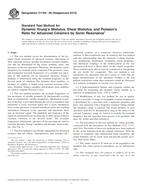 ASTM C1198-09(2013)..
ASTM C1198-09(2013)..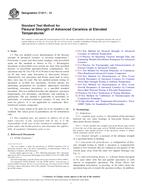 ASTM C1211-13
ASTM C1211-13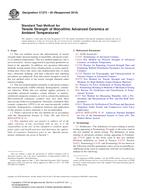 ASTM C1273-05(2010)..
ASTM C1273-05(2010)..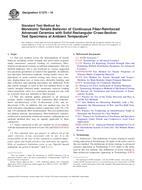 ASTM C1275-10
ASTM C1275-10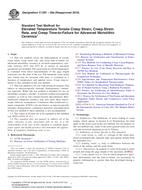 ASTM C1291-00a(2010)..
ASTM C1291-00a(2010)..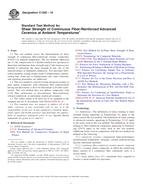 ASTM C1292-10
ASTM C1292-10
 Cookies
Cookies
